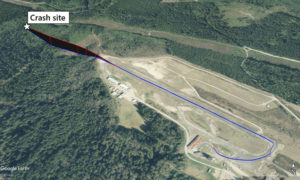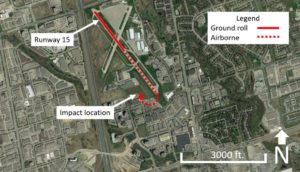January 10, 2019
TSB Investigation Reports Reveal Common Thread
admincopa
The Transportation Safety Board (TSB) released this week a number of investigation reports on light aircraft accidents, all three of which ended in fatalities.
On British Columbia’s Sunshine Coast, a Piper PA-28-140 Cherokee (C-GVZP) crashed into trees approximately 650 metres off the end of Runway 29 at the Sechelt airport (CAP3). The July 5, 2018 accident resulted in one fatality, the pilot, among the four family members on board the aircraft (two adults, a teenager and a child). It was to be the second sightseeing flight operated for family members that day.
The wind had been from the west during the earlier flight, and continued so while the pilot loaded the aircraft for the second flight. However, by the time he took position on Runway 29, the wind had become easterly. The aircraft became airborne approximately three-quarters of the way down the 2,400-foot runway. After climbing for several seconds, the Cherokee began to wallow. It maintained a nose-up attitude as it lost speed and, after crossing a ravine at the end of the runway, collided with trees after 30 seconds of flight. The three passengers escaped with minor injuries.
The TSB report noted that Runway 29 slopes slightly upward at an average of one percent (0.6°), and that this is not noted in the Canada Flight Supplement (CFS) nor is it indicated at the airport itself. Being a registered aerodrome, rather than a certified one, runway slope information is not required, but is optional. Also noted was the occasional presence of downdrafts and turbulence over the ravine, a phenomenon well known by local pilots, and that it too is absent from the CFS.
The TSB calculated the aircraft weight to be at or near gross. Weather conditions at the time of flight indicated a probable density altitude of 1500 feet. The TSB did not find any indication that the engine or any aircraft system was not performing as they should.

The following week, on July 12, 2018, the pilot of a privately-registered Bellanca 8KCAB Decathlon (C-GDLP) declared an emergency in the climb-out from Runway 15 at Toronto’s Buttonville airport (CYKZ) on a day with good weather conditions. Witnesses on the ground reported hearing ‘irregular’ engine noises emanating from the aircraft, which then began losing altitude rapidly while turning west. The Bellanca struck the ground in a right-bank, nose-down attitude. A post-impact fire ensued and the pilot was fatally injured.
A subsequent tear-down of the engine by the TSB resulted in no anomalies being found. Most of the rest of the wooden airframe was consumed by fire and no clues as to the cause of the accident were derived from it. The investigation also revealed that, although the pilot held only a student permit, he had logged around 111 hours of solo flight, with only 3.3 of them under the supervision of a flight instructor, contrary to regulations.

Two weeks later and back across the country near Black Diamond, Alberta, the pilot of a Piper PA-28-161 Warrior II (C-GVZJ) attempted to take off from a hayfield he had landed on earlier the same day (July 29). After barely leaving the ground, the aircraft struck bales of hay causing it to crash and rupturing the left fuel tank. A post-crash fire destroyed the aircraft.
Neither of the two occupants of the Warrior, both of whom were licensed pilots, was wearing available shoulder belts, and both sustained head injuries. However, the lap belts were used. One of the occupants was able to exit the aircraft. However, the other did not and died on the scene. Investigators were unable to determine who was acting as pilot-in-command.
The airframe was largely destroyed by the fire, and investigators were not able to determine if there was a control problem. Subsequent tear-down of the engine did not reveal any anomalies. Investigators did, however, note that the field was not prepared for aircraft use, with remaining hay three to four inches high. The field length was about 2,350 feet long.

All three of the above incidents are connected in that they occurred during the takeoff phase of flight. While the cause of the Buttonville accident remains unknown, the TSB stresses the importance of proper pilot training in handling the aircraft in emergency situations. The remaining two accidents suggest that closer attention be given to aircraft performance and runway conditions before flights are attempted.
